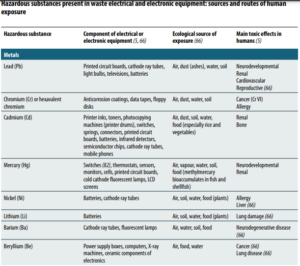In news – The recently published WHO report titled ‘Children and Digital Dumpsites’ underlined the risk children working in the informal processing faced due to discarded electronic devices or e-waste.
Key highlights of the report-
- According to the report, more than 18 million children, adolescents and 12 million women working at e-waste dumpsites in low- and middle-income countries are potentially at the risk of severe health hazards.
- This e-waste is dismantled and recycled by children.
- It contains over 1,000 precious metals and other substances like gold, copper, mercury and polycyclic aromatic hydrocarbons.
- The processing is done in low-income countries, which do not have proper safeguarding regulation and which makes the process even more dangerous.
- Children are given preference because of their small and dexterous hands.
- About 53.6 million tonnes of e-waste was generated in 2019.
- Only 17.4 percent of this e-waste was processed in formal recycling facilities.
- The rest of it was dumped in low- or middle-income countries for illegal processing by informal workers.
- Processing e-waste exposes women as well as their children to these toxins, which can lead to premature births and stillbirth.
- The hazardous impact of working at such sites is also experienced by families and communities that reside in the vicinity of these e-waste dumpsites.
- Children working at these ‘digital dumpsites’ are more prone to improper lung function, deoxyribonucleic acid damage and increased risk of chronic diseases like cancer and cardiovascular disease.

E-waste status in India
E-waste typically includes discarded electronic devices such as computers, televisions, mobile phones, tablets and other video and voice recorders, as well as electrical appliances, both heavy and light. About 95 per cent of India’s e-waste is recycled in the informal sector and in a crude manner. India’s 1st e-waste clinic was opened in Bhopal, Madhya pradesh.
E-waste management rules- 2016-
- Manufacturer, dealer, refurbisher and Producer Responsibility Organization (PRO) have been introduced as additional stakeholders in the rules.
- The applicability of the rules has been extended to components, consumables, spares and parts of EEE in addition to equipment.
- Compact Fluorescent Lamp (CFL) and other mercury containing lamps brought under the purview of rules.
- Collection mechanism based approach has been adopted to include collection centre, collection point, take back system etc for collection of e – waste by Producers under Extended Producer Responsibility (EPR).
- Option has been given for setting up of PRO , e – waste exchange , e – retailer, Deposit Refund Scheme as additional channels for implementation of EPR by Producers to ensure efficient channelization of e – waste.
- Provision for Pan India EPR Authorization by CPCB has been introduced replacing the state wise EPR authorization.
- Deposit Refund Scheme has been introduced as an additional economic instrument wherein the producer charges an additional amount as a deposit at the time of sale of the electrical and electronic equipment and returns it to the consumer along with interest when the end – of – life electrical and electronic equipment is returned.
- The manufacturer is also now responsible to collect e – waste generated during the manufacture of any electrical and electronic equipment and channelise it for recycling or disposal and seek authorization from SPCB.
- Dealer or retailer or e – retailer shall refund the amount as per take back system or Deposit Refund Scheme of the producer to the depositor of e – waste.
- Refurbishers need to collect e – waste generated during the process of refurbishing and channelise the waste to authorised dismantler or recycler through its collection centre.
- The roles of the State Government have also been introduced in the Rules in order to ensure safety, health and skill development of the workers involved in the dismantling and recycling operations.
- Department of Industry in State or any other government agency authorised in this regard by the State Government is to ensure earmarking or allocation of industrial space or shed for e – waste dismantling and recycling in the existing and upcoming industrial park, estate and industrial clusters.
- Liability for damages caused to the environment or third party due to improper management of e – waste including provision for levying financial penalty for violation of provisions of the Rules has also been introduced.
- Urban Local Bodies (Municipal Committee/Council/Corporation) have been assigned the duty to collect and channelize the orphan products to authorized dismantlers or recyclers.
E-waste (Management) Amendment Rules, 2018-
- The e-waste collection targets under EPR have been revised and will be applicable from 1 October 2017.
- Separate e-waste collection targets have been drafted for new producers, i.e. those producers whose number of years of sales operation is less than the average lives of their products. .
- Producer Responsibility Organizations (PROs) shall apply to the Central Pollution Control Board (CPCB) for registration to undertake activities prescribed in the Rules.
- Under the Reduction of Hazardous Substances (RoHS) provisions, cost for sampling and testing shall be borne by the government for conducting the RoHS test.
















